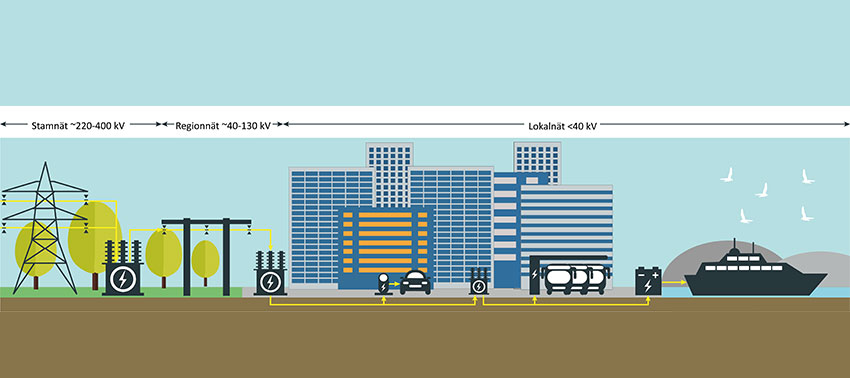Large-scale electrification of transport – is it possible?
The City of Stockholm has a long-term goal that the city shall be fossil-fuel free by 2040. An important part of reaching this goal is transport electrification, which includes all transport types: cars, car-sharing, buses, taxis, ferries, etc. However, there are physical and technical limits regarding how much electricity can be produced and delivered to vehicles – is it possible to reach the desired large-scale electrification needed to reach the city’s climate goals?

Trivector has completed a study for the City of Stockholm regarding the consequences of a large-scale electrification of the vehicle fleet, and how the city authority can work to support an increased level of transport electrification. The focus in the study was of the technical and physical aspects related to transport electrification.
Local bottlenecks in capacity
Opinions differ on whether a large-scale electrification of the transport sector will lead to electricity supply problems. Most experts, however, do not see the total demand as a problem. The transport sector’s future demand for electricity is expected to be small in comparison to other sectors, while large energy savings are expected in other parts of the network. However, local bottlenecks in capacity may occur. In Stockholm, problems are mainly evident in the high and medium voltage transmission networks delivering to Stockholm. At the local level (low-voltage network), in Stockholm’s urban areas, it is a large challenge to find physical space for the infrastructure (substations) that will be needed to be built to enhance the distribution network. Other challenges relate to lack of workforce availability and the need to re-route traffic under construction periods for structural enhancements.
”There is a lack of understanding of how a large-scale electrification of the transport sector can impact the electricity network in the future. Transport will be a part of the energy system in a way that it isn’t today, and this leads to new challenges for both the transport and energy sectors” says Anna Clark, project manager for the study. A pro-active strategic planning is needed whereby electricity companies take consideration of the energy demand required for the transport sector. This requires a common understanding of which type of vehicles will be electrified, as well as the charging needs they will have. There are also challenges relating to the fact that future transport patterns will probably be different from today’s – what kind of infrastructure will be needed?
Placement of public charging places
The city government has an important role to play in supporting the identification of suitable places within the urban realm where new substations can be placed to enhance the distribution network. There are many competing claims to space in the public realm, and it is important that electricity network requirements are considered early in the planning process. According to several predictions, most charging points will be located at home in the future (as they are today). Public charging points can be used as a complement to home charging. Today public on-street charging points also play a role in marketing and making electric cars more visible. In the future, the placement of public charging places may be different.
Especially in the denser parts of the city, street-space should be used for high-capacity modes of transport such as walking, cycling and public transport. Charging points can be situated, for example, in parking garages, at public transport nodes, taxi ranks, and with larger infrastructure, such as at harbours. The use of the public realm, which is managed by the city, requires making priorities between different stakeholders. Infrastructure that supports transport electrification is just one puzzle piece that needs to fit into the large picture. The city has a role to play in supporting the grid operators in identifying appropriate places and solutions to integrate grid infrastructure into the city environment. Cooperation between local and regional authorities and grid owners and operators is an important next step. The question remains: who will take the lead?
More information
For more information, please contact Anna Clark, +46 10 456 56 23, project leader for the study.

